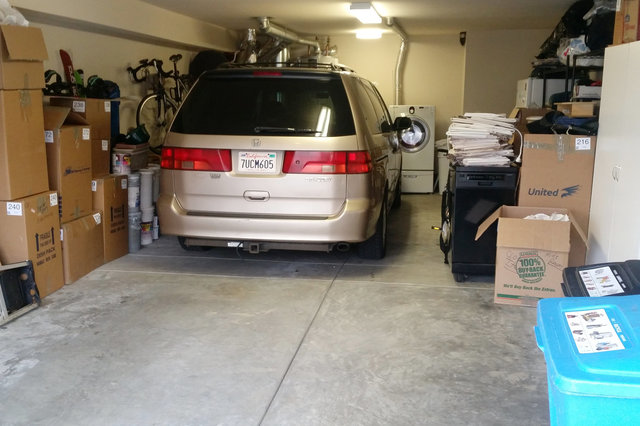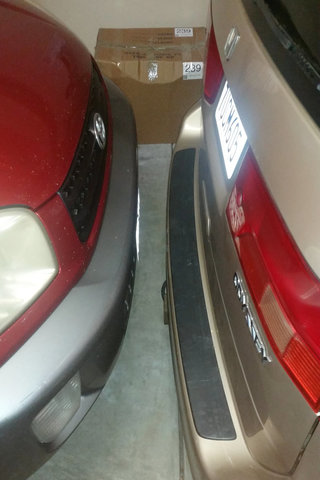Parking in San Francisco
Started: 2017-05-14 15:47:04
Submitted: 2017-05-14 20:05:07
Visibility: World-readable
In which the intrepid narrator decides his cars are not right for San Francisco but decides to keep them anyway because nothing else works better
Two years ago, faced with a growing household, and the prospect of not being able to comfortably fit everyone into our Rav4, we bought my parents' 1999 Honda Odyssey, the same minivan that provided the transportation for much of my home life while I was in college. This worked well enough in the suburbs of Colorado, but when we moved to San Francisco last year we found that neither of our vehicles were well adapted to the requirements of urban living.
Motoko, our Rav4, is a small and versatile, but she isn't large enough to take our au pair (or any other guest) along with our family. (She technically has three seatbelts in the rear seat, but with both kids in car seats this doesn't leave much room for an adult to sit in the back. Kiesa did it, once, and does not seem inclined to repeat the experience.) Julian's bulky toddler car seat takes up more room in the back seat than an adult would, so we have to move the front passenger seat up far enough that I can't sit comfortably in the seat. (This particular problem got somewhat better when Julian turned two and we moved him into a forward-facing car seat that wasn't as deep as his older seat.) It's stick-shift, which is something of a liability in San Francisco's hills (especially since San Francisco's city planners decided to lay out the city on a strict grid system without regard to the local topography). This is not normally a problem for me (though I did have to replace the clutch shortly after moving to the city last year) but Kiesa does not like driving stick up and down the hills. The one thing Motoko distinctly has going for her is her chassis: she's built on a compact car chassis, so she can fit in almost any parking space.
The van is roomy enough to fit our entire household with room to spare, and has plenty of room for the cargo we need for any road trip. The main problem is that the interior space comes at the price of exterior space. The van is hard to park and hard to reliably maneuver around San Francisco's crowded urban streets.
The other problem is that the van is showing its age. The right exterior sliding door handle has broken off, and the van was subjected to various scrapes and injuries, mostly (but not exclusively) at the hands of our first au pair. The van's age has contributed to some other operational problems; in particular last fall the battery died and wouldn't start the car. We have a couple of portable batteries for jump-starting cars (one of which permanently lives in the van now), but that requires opening the hood, and the hood latch will only open when I push a screwdriver handle under the handle and push up. I took the van into my city mechanic, who replaced the battery (and also convinced me to replace the brakes, which may or may not have been a good idea), and suggested I get a trickle-charger to keep the battery from discharging because we drive the van on average once every month. (At this point we lived in our rental house in Mission Terrace and parked the van inside the garage and Motoko on the driveway. This tandem arrangement worked ok most of the time, but it did prove awkward when I decided I needed to take the van for some reason and Motoko was still parked in the driveway. I took BART to work every day; Kiesa drove to work in Mountain View but started to transition to taking Caltrain when she could.)
The new battery worked ok for a month (long enough to get us up to the Logan family reunion for Thanksgiving and back), but by mid-December I needed to jump-start the car again (while on my way to see Rogue One with Calvin). This got worse as we moved into our house in Ingleside; we parked the van in the garage and juggled street parking for Motoko, which proved to be a pain. (We couldn't reliably park anything in our driveway, which included an elaborate twist to transition from the 22% down grade on the street to the flat grade in the garage. We also learned that the City of San Francisco claims a 15-foot sidewalk, on which we're not supposed to park, though judging from our neighbors this does not appear to be reliably enforced.)
It seemed to me that some part of the car's electronics were causing the battery to drain faster than normal. It wasn't immediately apparent what, though; I was careful to turn off the lights when leaving the car, and there was nothing obviously on. Then I noticed that the driver's side sliding door tended to lock itself at random, and it kept making constant solenoid clicking sounds, as if it were locking itself regardless of whether it was currently locked or what the state of the engine was. I tried to disassemble the door to see what I could do with the lock. I pulled the electrical contact off the door, and inside the body of the door I could see the connector where the door's wiring harness plugged into the lock, but I couldn't undo the connector through the small hole I had available. I poked at the door panels but decided against trying to take the entire door apart just to get at the wiring harness. I ended up leaving the contact off. I could still close the door, and the mechanical lock worked. I couldn't automatically lock or unlock the door, but at least it wasn't locking itself at random. With this hack the battery no longer discharged itself while the car was sitting in the garage, and with the help of a trickle charger I was able to charge the battery and keep it up and running. We could use the van again, but we still had a problem fitting both cars in the garage.
When we moved into our house in Ingleside, I measured the length of the tandem garage, compared it to the length of our cars, and came to the idea that the garage was too short to fit both cars in the garage. (It may not have helped that the washer and dryer were placed, somewhat awkwardly, at the very end of the garage, to the point where I'd have to lean over the hood of a car parked right in front of the front-loading washing machine to load or unload clothes.) At first this was a moot point anyway, while we unpacked the garage to the point where we could actually park cars in it. Then we got tired of trying to juggle street parking (including the unfortunate fact that the surrounding blocks are a neighborhood parking district but our street is not, so we can't park there for more than two hours during the week because we don't live on the right streets) and tried to figure out what to do about our cars. We really only need one vehicle, and we don't need that vehicle every day, but that vehicle should be compact on the outside, roomy on the inside, and not soul-crushing like a minivan. (I want a Toyota Innova but it's not offered for sale (or legal to drive) in the United States.) These criteria, unfortunately, do not describe a car that actually exists.
Then I went back to the garage to redo my measurements, and discovered that I'd rounded wrong: I could fit both cars in the garage, tip-to-tail ("tandem parking"), with nine inches to spare. This was not a lot, but it was enough: I cleared out enough space in the garage, pulled the van all the way forward, and (just barely) fit both cars in the garage. This was way easier than trying to juggle street parking.
I still want to reoptimize our vehicles for our current lifestyle, but until I figure out what that really means I'm content with the status quo for now.





